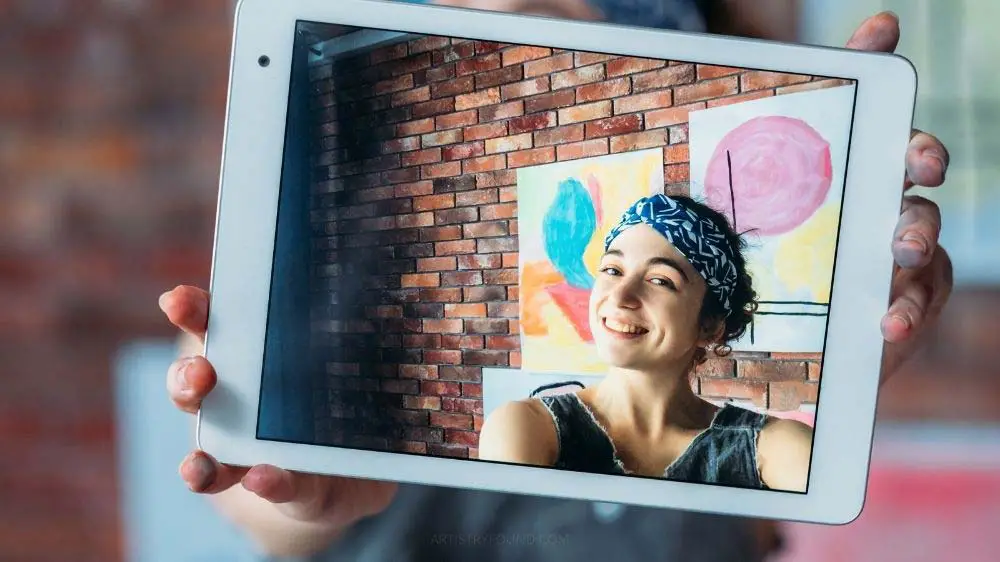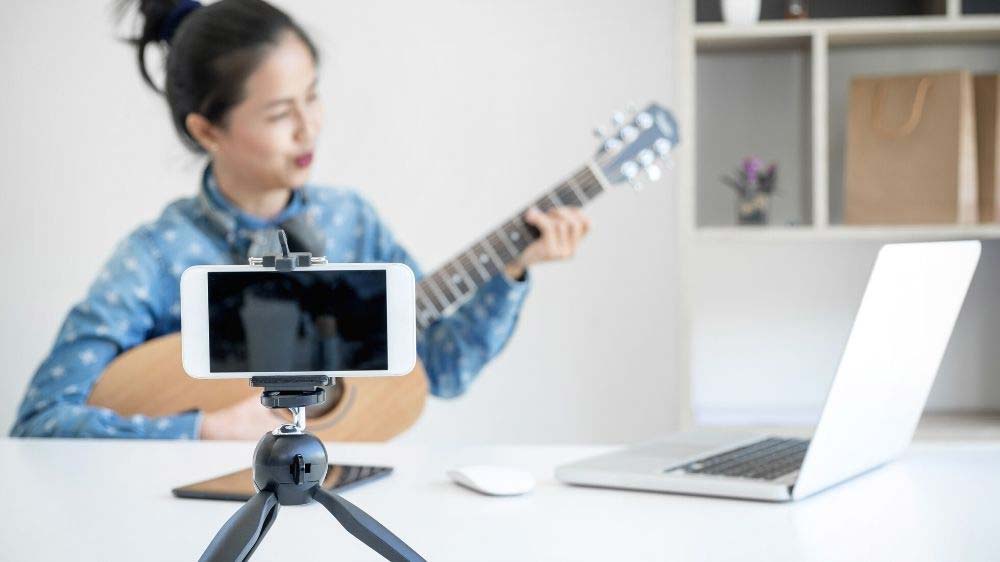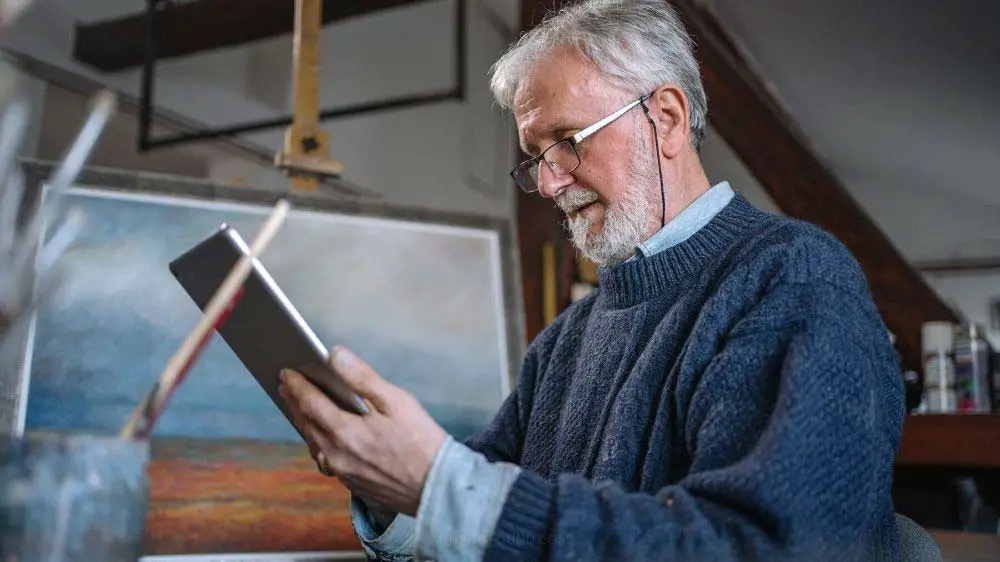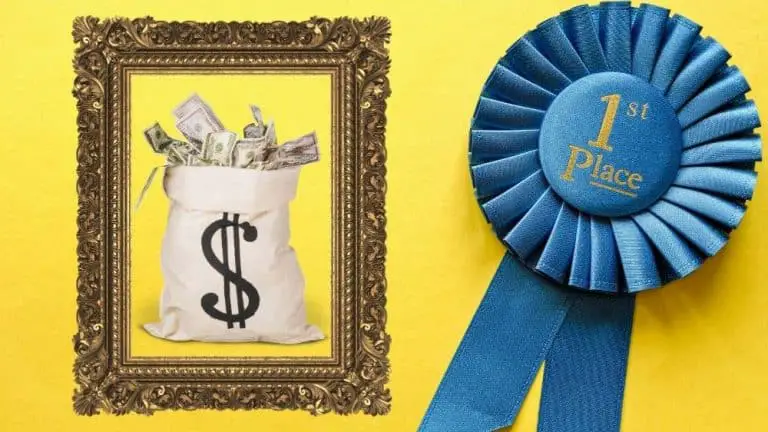Can You Be An Artist Without Social Media? (The Truth!)
In today’s art world, social media can be a great way for an artist to get their work out in front of the public, make industry connections, and increase their art sales. However, you may have realized that social media can also be a stressful, time-sucking, emotional vampire!
While many art careers rely on technology and social media in order to flourish, what if you just can’t stand it! Can you be an artist without social media?
You can be an artist and sell your artwork successfully without using social media. It is difficult, however, to sell your work today without using social platforms. An artist will need to use other marketing tactics like local outreach or have their own website to get in front of their audience.
It may seem like a struggle to be known in the art world nowadays with so much competition and the need to be in contact with as many people around the world as possible, thanks to globalization. Social media is an easy way to facilitate this connection; however, managing social media websites is an art of its own.

(This article may contain affiliate links and I may earn a commission if you make a purchase)
Social Media For Artists: Yea or Nay?
Social media has rapidly become a part of everyone’s lives. Its importance started with millennials but has since expanded into every generational spectrum over the past fifteen years.
Love it, or hate it, social media isn’t just a fad that’s going to disappear in time. The specific platforms may come and go, but social media has forever changed how we communicate with each other. Many professional fields rely on social media to communicate with their customers and followers. From local businesses to worldwide conglomerates, social media is a large part of doing business in today’s world.
Being that social media provides a very visual way to communicate, it comes as no surprise that artists around the world have adopted social media as a primary way to market themselves and their work. But does every artist need to participate on social platforms to succeed?
Art comes in many different forms, and as such, there are different career paths that a person can take to be considered an “artist.” Each individual artist may or may not benefit from social media depending on their specific career path, personality, and goals.
So first, let’s take a look at some of the reasons why an artist wouldn’t want to be active on social media.
Arguments Against Artists Using Social Media
A large misconception with social media is that the more followers you have, the more people will buy your work. While having a large following across many social media platforms does raise awareness of your artwork, it doesn’t guarantee that your artwork will sell.
It’s better to have fewer followers who are more dedicated to your work than thousands who won’t even really look at it.
Using social media also provides opportunities for plagiarism by less motivated artists. Additionally, many artists believe you are giving away your content for free. These are just a couple of risks that artists have to accept when they use social media. But there are others.
Artists, Social Media & Mental Health
Some professional artists complain that managing a social media account can be stressful. Many artists choose to pay someone to manage their social media accounts for them. Other artists have left social media, stating they are relieved from the stress of managing a social media account.
Artists who are just starting out may also feel discouraged while using social media. Rather than focusing on building their portfolio and reaching their target market, artists tend to look at work similar to theirs and compare the quality of their work as well as their following.
Comparing yourself to others online has also contributed to a rise in depression rates (this is true of both artists and non-artists alike). Imagine working hard on a social media platform for several years only to find a newcomer who has more likes and followers than you. It’s easy to feel that they have succeeded while you have somehow failed.
For Artists, Social Media is a Hamster Wheel
Another argument against using social media for displaying and selling your artwork is that it can be time-consuming. Responding to messages (both good and bad), scrolling through feeds, and constantly making yourself available to the public can take a toll on your artwork and productivity time. It’s like running on a never-ending hamster wheel.
Some artists and music producers state that you can feel trapped once you start using social media for your artwork. It can be difficult to leave social media, especially if you’ve gained a significant following and depend on it for your work.
Artists also fear that they will be forgotten if they leave social media. Leaving social media, or even taking a break, can quickly reduce your ability to reach your fan base. Followers of most social media accounts have short attention spans and will forget an artist and their work if they aren’t constantly reminded.
Succeeding as an artist on social media can become a full-time job in itself, leaving very little time and energy for actually creating art.
Social Media Can Cause An Artist to Lose Work
There was a time where artists spoke almost entirely through their work. However, the advent of social media has given well-known artists, celebrities, and performers a platform to speak their minds. Unfortunately, this is not always a good thing.
While an artist may create wonderful works of art that people love and rave about, a poorly worded or tasteless social media post can cause an artist to lose part of their audience or even their career. For instance, a painter whose known for painting beautiful, relaxing landscapes may decide to share their personal political opinions on social media, instantly causing them to alienate up to 50% of their audience.
Before social media, people only had to worry about being recorded saying things. Now, people need to not only be careful with what they say out loud but also what they say online. Some artists in different areas, especially actors, have been punished for things that they say online, such as Gina Carano losing her role on “The Mandalorian” for several offensive tweets.
Opinions shared on social media may have nothing to do with an artist’s talent or ability but can cause very big problems that negatively affect their careers.
In fact, some people even theorize that social media would have destroyed the careers of many historically famous artists and writers. Between intense online criticism, memes, and blatant theft, artists of the past may not have fared well in an online world.
Artists and Social Media Algorithms
Different and ever-changing, social media algorithms are also a reason not to depend on social media to let others know about your work. In addition, social media algorithms often have a negative effect on an artist’s ability to communicate with their audience through censorship and filtering systems that can limit which of your posts people see.
We all know our social media feeds are curated for us to see things that advertisers want us to buy. Influencers and artists on Instagram have been feeling the effects of these changes, as their posts are being bombarded with sponsored content.
Increasingly, social media platforms are serving as gatekeepers for information, including art. What gets seen or doesn’t, who becomes famous or not, which ideas take off or don’t get traction at all, are decided by an algorithm whose sole purpose is to make the platform more money.
In addition, two of the most popular online platforms for art, Facebook and Instagram, seem to be limiting an artist’s ability to reach their own followers. Facebook, for instance, will only show an artist’s post to a small percentage of their followers unless the artist pays Facebook to “boost” the post.
Once a social media website becomes popular and successful, they slowly begin to restrict information sharing to those willing to pay.
Arguments for Artists To Use Social Media

All the negatives aside, social media is a great way for artists to share their work with an engaged audience and simultaneously gain more attention from people outside the art world. As an artist on social media, you will have access to millions of people to advertise and sell to, but you have to be committed and know how to reach your specific market.
Some artists will even go so far as to suggest that you must use social media if you want art to be your career rather than a side job. The truth is that many galleries will be far more interested in working with you if you have a successful social media following, as it makes it easier for them to promote your work.
Social media platforms, such as Instagram, can also perform well as a quick and easy portfolio to share when the opportunity arises to show your work to friends, colleagues, or even someone influential.
Some visual art mediums that work particularly well on social media are:
- Painting
- Sculpture
- Photography
- Drawing
Note: Really, any medium that you can digitize to share as either an image or video can perform well on social media.
Without a doubt, social media can be a valuable tool when trying to promote your work as an artist. However, for some people, it seems effortless, while for others, it can be as unpleasant as a trip to the dentist!
How To Promote & Sell Your Art Without Social Media
Our society has become so dependent on social platforms that it’s difficult to think of a time and a world without it. Art, however, has been bought and sold for centuries, long before the advent of social media. Many of the methods used to sell art before social media are still quite viable today.
Here are some ways you can successfully sell your artwork without social media:
Staying Local and Raising Awareness of Your Artwork
One timeless way to sell your artwork without social media is to focus locally.
Many local communities host open-air markets to allow local artists to sell their work. Check with your local chamber of commerce and keep an eye out for community markets that are looking for vendors and artists.
Opportunities even exist for you to travel outside your city or state. For example, many artists make a full-time career by participating in art fairs that take place throughout the country during the year.
Older generations have an advantage that they can use to trump younger generations when it comes to doing business and living life without social media. How did older generations meet up with each other before cellphones? One way to sell your artwork without social media is to look back and learn how art sales were made before the online market existed.
If you read or watch any artist’s biography, it was almost never easy for them regardless of their medium. Many artists had to struggle to get their work known, and they hit many roadblocks along the way. Just as before, today’s artists need to be determined to get their work known and be willing to listen to criticism and improve upon their artwork.
Creating your own website and a blog is a phenomenal way to sell your artwork without using social media. You’re more likely to gain a loyal following (in addition to sales) using a website and a regular newsletter instead of a social media account. You can also use Pinterest (a visual search engine) to ensure your artwork appears during searches for potential buyers and commissioned work.
Reaching Different Markets With Your Art
Before selling your artwork, with or without the internet’s help, consider what market you want to enter. If you’re going to reach a younger crowd, you will have to bite the bullet and use social media to promote your work. Digital art also requires an online presence as well.
Once you have discovered your market, creating a product that they want is essential. Discover what art your potential customers want to buy in addition to what you’re already selling. Check websites like Etsy or Pinterest to find ideas similar to your niche, as well as comparing pricing.
Artists can still have an online presence without social media if they have their own website and portfolio. Artists will also have a place where people can buy their art, whether it’s a brick-and-mortar storefront or an online store.
Finally, as an artist, you may realize that a completely different market than what you’re targeting is buying your artwork. Don’t think of this as a failure. Rather, think of it as truly discovering your market, and instead of changing your artwork, change your art marketing strategy to reach the newly discovered market better.
Art Mediums Decide The Marketing Route

Regardless of what medium you use to create your art, you want to sell it. Some mediums are naturally more difficult to sell online, such as sculptures and paintings. Many art buyers enjoy seeing the artwork in person to gain the feeling of the piece before purchasing (of course, without touching!).
Since we have been using computers for practically everything these days, art has taken on digital forms in many different ways. From digital paintings to animation, digital art may need some sort of social media or digital communication to raise awareness and sell the artwork.
Tattoo artistry is another form of artwork that has recently taken to not only social media but reality TV as well. Many tattoo artists appear at conventions and hold a social media following on their personal and shop pages. If you’re a tattoo artist and don’t want to depend on social media, a great way to sell your work is to appear at conventions.
Music is another art medium that social media and reality TV have impacted. Before social media, musicians would record their music and send their work to producers. Now, musicians upload their music videos and tracks to YouTube, Soundcloud, TikTok, and Instagram in hopes of being discovered by a producer.
You’ll need to choose the marketing technique (online, off-line, or social media) that matches your artistic medium.
Being an Artist Without Social Media
Creating and selling art may not be for every artist. There are many other career paths that artists can take without solely sticking to selling their own products directly. Many talented artists work for companies to create artwork the company needs while still selling their own work on the side. Having an artistry job within a company is more reliable than depending on selling your own work.
Another way to be an artist without social media is to create freelance work and sell your services within a particular style. You can also submit your artwork to different art competitions if they fall within your style and niche. It’s a great way to earn money and make connections for job opportunities.
There are hundreds of different fields that artists of any medium can explore if they need a more reliable source of income and workflow than being an independent artist can give.
How to Use Social Media to Sell Your Artwork
Ten years ago, there were a handful of social media platforms. Now, hundreds of different social media platforms can connect you with thousands of people with similar interests. As mentioned earlier, consider the market you want to reach when selling your artwork to know which types of social media to use.
Social media can be an excellent marketing outlet with free or low-cost advertising available, which can be helpful to many beginners and emerging artists. However, there are several things artists need to consider when selling their art on social media:
- Time management
- Socializing with your audience
- Giving value to your work
Time Management and Social Media
As mentioned earlier, time management is essential for anyone using social media. People can easily spend hours scrolling through their feeds and answering messages without realizing the amount of time they’ve spent.
As an artist using social media, you must have set times that you work on your portfolio and times to build your social media presence. To push it even further, you must also add in time to send your portfolio to galleries for reviews, so you have opportunities for commissioned jobs and selling your artwork.
A great tip for time management with a busy schedule like this is to plan your week ahead. As an artist working through social media, freelancing can be taxing on your mental health because you will spend more time working than someone working a nine-to-five. Divide your day into time for social media, reaching out to galleries, and building your portfolio. Don’t forget some time for yourself!
Resist the temptation to look at your phone while you’re in the middle of the creative process. Instead, turn it off or put your phone on silent, place your phone out of eyesight, so you’re less likely to become distracted from your work.
Socializing With Your Social Media Audience
Another important aspect of having a social media presence is socializing with your target audience. Just as you would socialize with potential buyers and contractors at galleries and conventions, you should find ways to socialize with them online as well.
Try not to spend too much time socializing online because even though it is called social media, you are just using it as a platform to raise awareness of your product and selling it. Instead, use the time that you dedicate to building your social media presence to respond to any messages.
Another way you’ll end up socializing with your audience is that you will let them know who you are. You can tell everyone about your journey to promote your work and your brand. You can also communicate with your audience by showing videos of you creating your work or explaining different techniques.
Beware of Social Media Trolls
Critics have been around as long as there’s been something to analyze and judge. Some forms of severe criticism have even ventured into “bullying” territory, especially when it demeans the creator rather than the work produced. Social media platforms have created a space to allow cyberbullying and trolling anonymously.
While many influencers are popular targets of cyberbullying and trolling, artists are common targets as well. It may make an artist want to quit social media, make their page private, or publicly retaliate. However, a saying goes with internet trolls, “Don’t feed the trolls.”
If you suspect you’re a target for cyberbullying and online trolling, contact the social media platform’s customer service to report the account(s) harassing you.
Trolling and cyberbullying can be extremely discouraging for any artist trying to show and sell their work on social media. Remember to acknowledge if they are criticizing you or your work before having a negative reaction.
Use Social Media To Give Value to Your Work
As a struggling artist, it may be tempting to reduce the cost of your work just to make sales and start having a loyal following. Before lowering the price of your artwork, remember the amount of time you spent creating it and how much money you spent on materials. As an artist, you’d rather find the right buyer for your work than the first buyer.
Having the right buyer for your artwork can also promote your work and skillset. For example, they may ask for commissioned work within your specialty. They can also refer you to others who are interested in your style.
You can give value to your work through social media in ways that artists without social media can’t. It gives you a platform to tell your story, how you became an artist, and why you choose to make and sell your artwork.
The Risks of Putting Your Artwork Online

People have been warning about thousands of potential risks of using the internet since the beginning of the online movement. As our computers and internet quality have improved, so have the software we use and the number of crimes committed over the internet.
One major risk of putting your artwork online is plagiarism. You can put watermarks on all of your work as much as you’d like, but people can remove watermarks and make creations very similar to yours. Even though the saying goes, “imitation is the sincerest form of flattery,” it’s impossible to wrap your head around that if someone else is getting paid for your work.
Become familiar with the copyright laws in your country and how they apply to material posted online. While some artists don’t mind their work being used without credit, others depend on credit as a potential source of income.
Keep in mind that even if an image is copyrighted and then stolen or used without your permission, it may be subject to fair use through transformation.
What Kinds of Artists Should be Using Social Media?
For hundreds of years, artists have been successful without social media. However, because social media has changed how we communicate with the world, more artists are switching to social media as an outlet for their sales.
Some artists dive into social media too quickly and feel overwhelmed, and leave shortly after signing up. Other artists, however, see more success with their work being on social media. Artists who should consider using social media to promote and sell their work are:
- Digital artists
- Craft and handmade artists
- Convention artists, such as painters
- Photographers
- Sculptors
- Musicians
- Videographers
Remember, you don’t just need to use social media to sell your artwork. You can also use social media to share your story to help give more value to your work. Create videos showing your creative process and how you work.
Give samples and sneak peeks for what customers and followers can expect in the future. Also, make sure to take full advantage of your artist bio on each platform.
The Best Social Media Platforms for Artists
There are hundreds of different social media platforms available for everyone to use. What makes social media even more special is that each platform caters to users with a similar interest. Here are the four best social media platforms for artists:
- Instagram: an easy-to-use social media platform owned by Facebook. You can upload photos and videos, as well as go live. Use trending hashtags to help you get discovered.
- DeviantArt: has been around for over twenty years and is commonly used for digital art, paintings, sculptures, and videos.
- Behance: is wonderful if you would like to get discovered by companies. Upload your work to show off your skills to hopefully end up in an art gallery or hired by a company.
- TikTok: has been gaining popularity in the last few years with videos. Any type of artist, including choreographers and musicians, should put their work on TikTok to help promote themselves.
Other Career Opportunities for Artists
If creating and selling your artwork independently isn’t working for you at the moment and you are struggling to get by, consider putting selling your work on the backburner for a bit. There are many different career opportunities available to artists regardless of medium. Even if you’re not selling art in galleries or making albums, you can still be considered an artist.
Some career paths will require extra training or some schooling, but in the end, you may discover that if you are a sculptor, you may enjoy cake decorating or chocolate sculpting even more! Which is another thing to consider if you’re struggling to sell your work. So rather than changing your career, maybe it’s time to try a different medium.
Some excellent fields artists enter are:
- Culinary and confectionary arts
- Art appraisals and working in a gallery
- Teaching
- Art and music therapy
- Video game design and animation
Conclusion
Ultimately, the decision is the artist’s, whether or not they want to use social media. It just depends on what the artist is comfortable with and how they want to be known. Most artists will dabble with social media, and while some enjoy sharing and selling their artwork online, others find it overwhelming and don’t want to have anything to do with it.
The fact is, you can be a successful artist without social media. Instead, you’ll want to use one of the non-social media marketing methods mentioned above to market yourself and your artwork to your fans.






